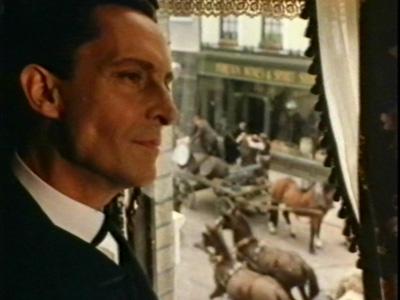
By Jonathan Morris, Antiscribe.com
With the sequel Sherlock Holmes: Game of Shadows being released on December 16, I thought I would take an always welcome trip down memory lane and look back at some the best and worst interpretations from cinema and television of Sir Arthur Conan Doyle’s famed creation, the world’s first and only consulting detective, Mr. Sherlock Holmes If you’ve read my earlier post (written two years ago), you’d know that I’ve been a huge fan of the detective for my entire life; there are very few versions of the character that I haven’t seen, along with some I wish I hadn’t seen at all…
This list isn’t meant to be a complete overview of all things Sherlockian; the character is the most reprised in film history, and entire books have been written that have tried to provide an adequate survey of all the various popular incarnations of the character throughout its long history. This list is simply an overview of my favorite adaptations, interpretations, and variations, represented as individual films, film series, and television shows, combined with similar productions that should perhaps otherwise be forgotten…
The Sherlock Holmes Film Series (1939-1946)
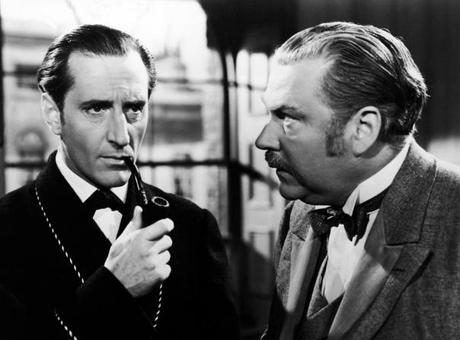
Basil Rathbone as Sherlock Holmes and Nigel Bruce as Dr. Watson in the Victorian age.
Certainly one of, if not the most famous Holmes and Watson team, the ineffable combination of Basil Rathbone and Nigel Bruce have undeniably been the most influential. Technically speaking, these are actually two series, the first consisting of the two fine period films produced at 20th Century Fox, The Hound of the Baskervilles and The Adventures of Sherlock Holmes (both 1939), and the second containing the 12 “B-movies” produced by Universal Pictures and set in what was then the modern day 1940s. Rathbone’s Holmes and Bruce’s Watson, through both the film series and a concurrent radio adaptation, pretty much established the characters within the public imagination. As Holmes, Rathbone was perspicacious, fearless, and tireless with a fierce sense of honor, justice, queen and country, while Bruce portrayed a Watson that was a stark contrast: bumbling, soft, comical, and slightly inept, but nonetheless very likable, loyal, and brave. It should be said, though, that Bruce’s comical Watson, derived from the character’s interpretation in the famous play by William Gillette, proved something of a disservice to Conan Doyle’s competent, everyman narrator. For better or worse, however, the dichotomy of the brilliant Holmes and buffoonish Watson remains popular to this day, though it has thankfully been in decline since the 1980s. While now regarded as one of the great villain performers of the classic Hollywood era, Rathbone unfortunately became typecast as the character after the series ended in 1946, and didn’t appear in an onscreen role again until 1954.
The Hound adaptation may be the best version of the most-filmed Holmes story, though as was typical for Hollywood, it added a romantic subplot that doesn’t quite hold up to scrutiny; due to the nature of the plot, though, Rathbone’s Holmes is off-screen for a large part of the story, but when he’s onscreen he’s perfect. Rathbone and Bruce were actually not considered the stars of the film, but the pairing proved so popular that they were reunited shortly thereafter for The Adventures of Sherlock Holmes. A reasonably definitive (if entirely non-canonical) Holmes-against-Professor Moriarty, Adventures remains a fun watch today, with marvelous atmosphere, an excellent musical score (by Robert Russell Bennett), and a clever dueling mystery at its core. The female lead was also played by young Ida Lupino, who went on to be one of the few, and sometimes the only, major female directors working in and around Hollywood during that era.
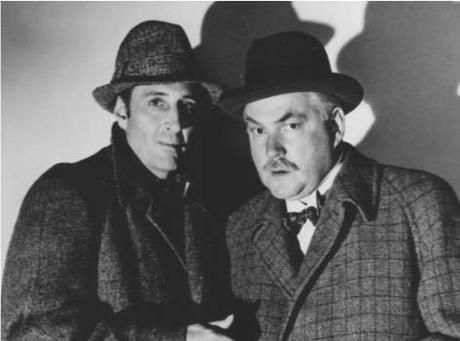
When the Rathbone and Bruce took their partnership to Universal Pictures, Holmes and Watson were updated to the 1940s to protect England from the Nazis during the Second World War.
The World War II era films are polarizing for some given that they transported Holmes and Watson out of their Victorian era and into the then-modern age. Personally, though, I enjoy them for what they are; the early films were still pretty faithful to the spirit of the character and many of them are adaptations of the original stories, even if Holmes was now chasing Nazi spies and saboteurs. I’m also willing to give them a pass on the updating given the context; there was, after all, a WORLD WAR going on, and portraying an icon of British culture in a positive way (as “ageless, invincible, and unchanging”) was as much good propaganda as it was cost-effective movie-making. Ironically, the series started going downhill when it dropped the Nazis as villains in favor of continuously recycling Professor Moriarty over and over again. The general consensus for the best entry in the second series is the very atmospheric and clever The Scarlet Claw, which featured Holmes and Watson hunting a killer in rural Canada.
Holmes Trivia Fact: The iconic phrase “Elementary, my dear Watson” was first popularized and ingrained into the lexicon after Rathbone uttered it in The Adventures of Sherlock Holmes and then repeated it throughout the other films and his radio series; the line never appears in any of the original Conan Doyle stories.
Sherlock Holmes (TV Series) (1954)
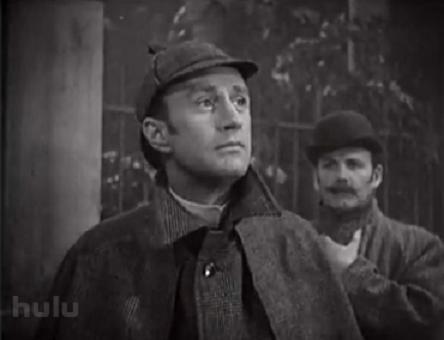
This half-hour series aired in American syndication starting in 1954, lasting only one season. Ronald Howard, son of the great Leslie Howard (and he’s the spitting image of his father) played a fairly witty and sharp-tongued Holmes; H. Marion Crawford was a stubborn, but tough Watson, and the series, I’m sure as a nod to World War II and Korean War veterans, played up his status as an ex-soldier. Given its age, some of the filming is obviously a little stodgy and the settings a bit phony and Crawford’s performances could also a little too broad. Howard, though, was a fairly good Holmes and the writing is better than expected. The series went mostly forgotten for many years, but with the advent of DVD and its ready availability due to its public domain status, the series has become rediscovered in the last decade by Holmes fans. Holmes Trivia: Though there have been a few TV movies that served as failed pilots, this is actually the only live action Sherlock Holmes television series produced by and for American television (unless, of course, you count House).
The Hound of the Baskervilles (1959)
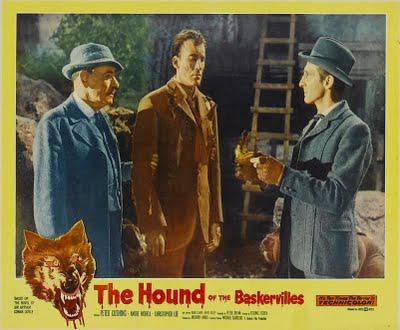
The famous British horror studio Hammer produced this unorthodox but effective version of the story, with its elements of gothic horror, not surprisingly, placed front and center. The legendary Peter Cushing, besides being the definitive Professor Van Helsing, was ideally suited to play Holmes (he also later reprised the part in a short-lived British Television series), and it’s rather quaint seeing the famed “Dracula” Christopher Lee playing something of straight man as Sir Henry Baskerville (not to mention seeing Cushing trying to save Lee rather than kill him). This film makes some considerable stylistic and content changes to the original story, adding overtones of sexuality and the macabre that certainly weren’t in the original Conan Doyle. Holmes Trivia: Hammer’s Hound was the first Sherlock Holmes movie to be shot in color.
The Private Life of Sherlock Holmes (1970)
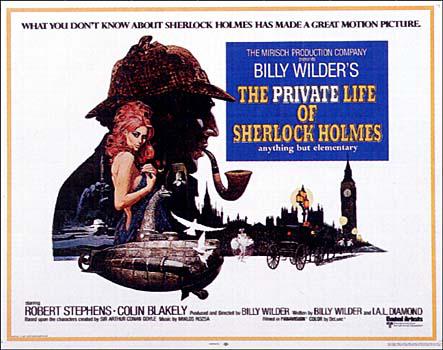
Perhaps one of the most underappreciated films of director Billy Wilder’s career and argued by some to be the best and most fascinating of all big screen Holmes films, The Private Life of Sherlock Holmes was a box office disappointment when first released as a roadshow attraction in 1970. Presented as the one Holmes story suppressed by Dr. Watson until the present day, the film, though not based on any of the novels, still proved faithful to many of the idiosyncrasies of Conan Doyle’s original character. It broke ground, in fact, by portraying some aspects of Holmes that all film and television interpretations had understandably repressed up until that point. Chief of these were his intermittent drug use, his bachelor status, and openly speculating about his unusual living arrangement with Watson. It was also one of the first to portray the great detective’s skills as sometimes being something less than infallible. Impressively, it’s all done with a great deal of affection for the original works and a sly touch of parody and humor. The great British stage actor Robert Stephens played Holmes (in one of his few starring film roles), and Christopher Lee again turns up, this time playing Holmes’s brother Mycroft. Private Life also featured one of the great film conductor Miklos Rosza’s most wonderful, and haunting, scores.
The opening titles of the film:
Holmes Trivia: Though the version in circulation is a little over two hours long, the original film was actually close to three hours in length, having been cut shortly before its initial release. Though some scenes have been recreated from elements, still photos, and soundtracks, the rest of the film, tragically, is believed lost.
The Seven-Per-Cent Solution (1976)
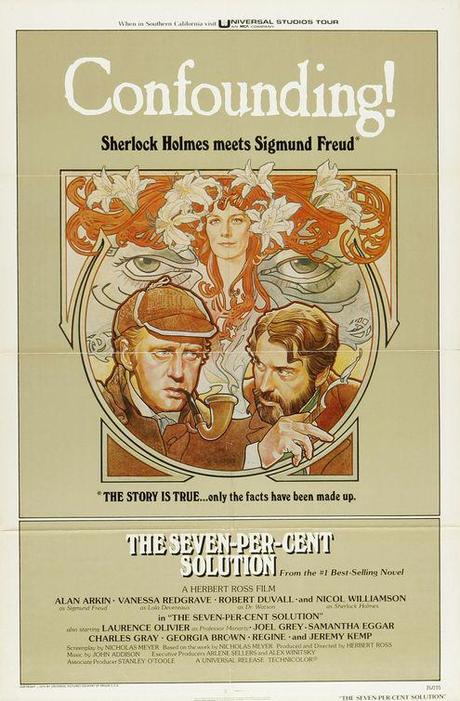
Based on the pastiche novel of the same name by Nicholas Meyer (who also adapted the screenplay), The Seven-Per-Cent Solution, which like The Private Life of Sherlock Holmes was also portrayed as a lost Watson manuscript, this rather offbeat adventure portrays a Holmes story specifically designed to run contrary to cannon. Driven to paranoid delusions by his ever-increasing cocaine use, Holmes (Nicol Williamson) has begun stalking a harmless mathematics professor named Moriarty (Laurence Olivier), irrationally accusing him of being “the Napoleon of Crime.” Concerned about his friend’s health and sanity, Watson (Robert Duvall – no, really, Robert Duvall) creates an elaborate ruse to lure Holmes to Vienna so he can receive therapy from none other than the great Sigmund Freud (Alan Arkin). Naturally, Holmes, Watson, and Freud get lured into an elaborate mystery plot, which eventually forces Holmes to confront a severe childhood trauma. A certainly unusual and atypical Holmes story, yet a very entertaining and compelling one, that fleshed out the background of one of the icons of literature, treating him ultimately more as a quirky, fascinating character than a popular archetype.
Holmes Trivia: Charles Gray, who plays Holmes’ brother Mycroft, later reprised the character in the Jeremy Brett television series.
Sherlock Holmes in New York (1976)
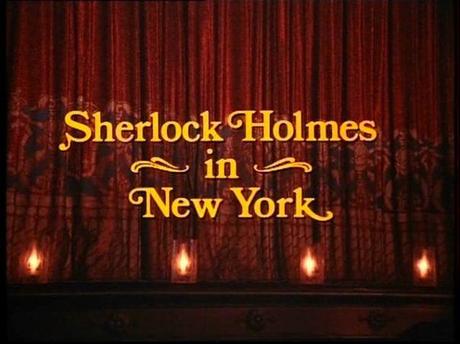
This rarely seen television movie, as best as I can tell, has never been released on DVD or even VHS, which is a shame as it’s a fun, literate little Holmes movie that boasts a terrific cast. Roger Moore plays Holmes (making him the only actor to portray both the great detective and James Bond on film), with Patrick Macnee as Watson, Charlotte Rampling as Irene Adler and John Huston as Professor Moriarty. The plot revolves around a vengeful Moriarty luring Holmes to New York City to protect the detective’s sometimes paramour Irene Adler; the evil professor then kidnaps her son (who suspiciously resembles Holmes) to blackmail his nemesis into refraining from investigating Moriarty’s latest “crime of the century.” Moore is clearly having a lot of fun as Holmes, and naturally makes for a fairly dashing detective, while Macnee pretty much fits the archetypal Watson to a “T.” Huston, though, very much steals the show as an especially grandiloquent and erudite Moriarty. The movie’s clever if a bit on the light side; in all it’s the kind of old fashioned Holmes they just weren’t making anymore. My only complaint is that Irene Adler, the character famed for having bested the great detective, is really little more than the love interest here.
Holmes Trivia: Patrick Macnee later played Watson again in the Sherlock Holmes: The Golden Years films (covered below) and Holmes himself in a Canadian TV movie called The Hound of London in 1993.
The Hound of the Baskervilles (1978)
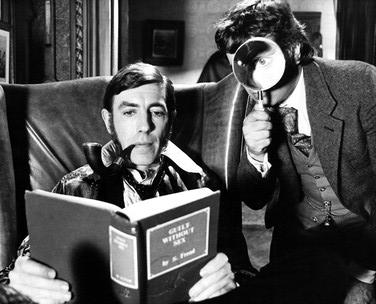
There have been many send ups of Sherlock Holmes over the years, and this one, most certainly, was the worst of the worst. Starring Peter Cook and Dudley Moore as Holmes and Watson, respectively, and directed by Andy Warhol protégé Paul Morrissey, this is just a mind-bogglingly bad, witless comedy that doesn’t even try to make a parody of Holmes mythology, instead aiming for some ludicrously cheap “gags” and bad gross out humor. Not at all funny, and one of those films that will honestly feel like a waste of your life. Not surprisingly, this film apparently sat on the shelf for three years; they probably should have just dumped in the Great Grimpen Mire…
Holmes Trivia: The very first known appearance of Sherlock Holmes on film was itself actually a spoof - the one reel, thirty-second long “trick” film Sherlock Holmes Baffled, produced in 1900.
Murder by Decree (1979)
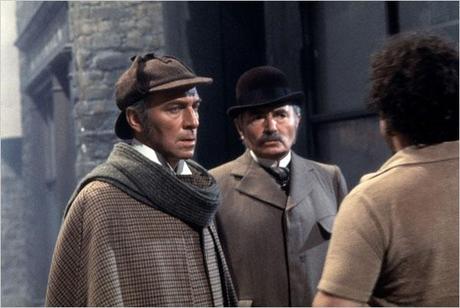
This one is perhaps one of the deepest and most emotionally compelling of all Holmes movies. Taking a mildly high concept idea, Sherlock Holmes pursuing Jack the Ripper, Murder by Decree does something rather interesting with it. Basing its narrative on Stephen Knight’s famous (and long since discredited) Ripper theory, which posited that the killings were part of an elaborate conspiracy between the Royal Family and the Freemasons, the film finds Holmes in the middle of a mystery that leads him into confronting issues of classism, civil unrest, and social welfare. Played by Christopher Plummer, the Holmes in this film was less an unfeeling, analytical thinking machine and more a caring hero with a social conscience and a pronounced political bent. In fact, a distinct undercurrent of the dichotomy between Plummer’s Holmes and the older, stodgier Watson (played by James Mason) is one, respectively, of liberalism and compassionate conservatism, with Holmes sticking up for the working class while being viewed as something of a malcontent by the police and government. Besides its subtexts, this is still a fairly atmospheric and intriguing Holmes mystery, though its tone can be wildly uneven at times; its director was Bob Clark, who, of all things, would later direct A Christmas Story; Plummer’s Holmes is perhaps my favorite from a non-English actor.
Holmes Trivia: Murder By Decree was not the first film to pit Holmes against Saucy Jack; the 1965 movie A Study in Terror related a similar story, and starred the recently deceased John Neville as Holmes. Irish actor Frank Finlay played Inspector Lestrade in both versions.
The Adventures/Return/Case Book/Memoirs of Sherlock Holmes (The Granada Television Series) (1984-1994)
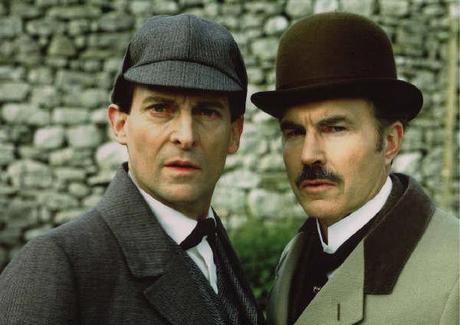
Jeremy Brett as Sherlock Holmes and David Burke as Dr. John Watson in the original Granada series "The Adventures of Sherlock Holmes."
This series hardly requires any real re-emphasis on my part, since it’s already widely regarded as the best and most faithful adaptation of Conan Doyle done to date. Produced by Granada television for airing on the ITV Network in Britain, its consists of six different series, totaling 36 episodes, with an additional five feature length specials, all of which were each specifically adapted from an original Conan Doyle story. The episodes were all handsomely produced period works, smartly written, with often superb casting…which was no more apparent than in its casting of the great detective himself. From “A Scandal in Bohemia,” the show’s first episode, Jeremy Brett’s introductory scene as Holmes:
One thing that is universally regarded as irrefutable fact among Holmes fans is that Jeremy Brett’s interpretation remains the undeniable best, ever. Played as charmingly erratic and eccentric, energetic and contemplative, deductively brilliant and deeply passionate, Brett created a Holmes that was a fully formed person of unique traits, quirks, gestures, and mannerisms. Though trained from an Edwardian theatrical background, Brett employed a more traditionally “method” approach to his Holmes, embodying him with some of his own character traits (Brett, being bipolar, was prone to mood swings) and basing his performance from extensive research from Conan Doyle’s stories.
What set Brett’s performances apart, however, were just how magnificently layered they were; while many great actors have superbly performed Holmes, Brett’s Holmes was himself always performing, always conveying one mood while secretly feeling another. For instance, he would sometime promote an air of callousness while hiding the fact he may be deeply sympathetic, or acting fearless when he was really afraid. It was these traits that made Brett’s Holmes seem less like a performer that his fans watched then a person that they all knew.
Often lost among the praise for Brett are the quality of the performances of David Burke and Edward Hardwicke, who played Watson at different points in the series’ run. Their Watsons were perhaps the most authentic put on screen: intellectually developed enough to be Holmes’s friend, fiercely loyal and brave, yet still lacking in the brilliance that made Holmes…well, Holmes.
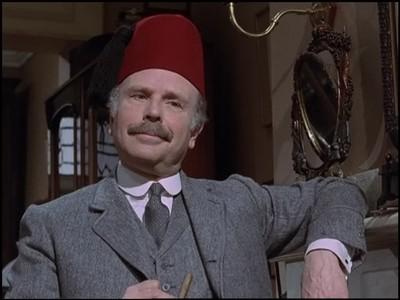
Edward Hardwicke, who replaced Burke as Watson beginning in "The Return of Sherlock Holmes," seen here rocking a fez. Since fezzes are cool, ergo Hardwicke's Watson was cool.
As great as the series was in its early years, it did noticeably begin to drop off after a point, especially as the writers had to start culling some of the more mediocre and underwhelming Conan Doyle stories for material. Also during the two-year hiatus between the two The Return of Sherlock Holmes series, Brett had a nervous breakdown and began taking powerful medication for his bipolar disorder. The treatments, unfortunately, caused his body to retain water and aggravated other aspects of his already fragile and declining health. Therefore, by the second half of the series, Brett’s appearance had changed drastically, and as he began to physically deteriorate it made the later episodes sometimes difficult to watch. Brett passed away on September 12, 1995 from heart failure while the final episodes of the show were airing on PBS affiliates in the United States.
From “The Cardboard Box,” Brett’s fitting final scene as Sherlock Holmes:
Holmes Trivia: The 1991 episode “Shoscombe Old Place” featured a young actor in a supporting role by the name of Jude Law, who went on to play Watson in the 2009 blockbuster.
Young Sherlock Holmes (1985)
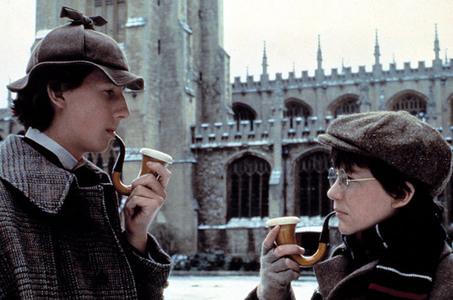
I’m always a bit torn on this one. On a personal level, it holds a distinct place in my heart because it was one of the films, along with The Great Mouse Detective, that actually got me interested in Sherlock Holmes when I saw it on video as a seven-year old. With that said, it still stands as an awkward mix of uneven mix of coming-of-age story, mystery tale, and painfully obvious Indiana Jones knock-off (in the UK the film was actually known by the very Jonesian title Young Sherlock Holmes and the Pyramid of Fear) that never really comes off as well as it promises to. The film tells an obviously non-canon story of a Young Holmes and Watson meeting at a boarding school as teenagers and getting involved in a murder plot involving an Egyptian death cult; all, of course, while dealing with young love, peer pressure, general teen angst, and a giant subterranean pyramid beneath London. To be fair, it’s not really a bad movie, just one that kind of falls victim to its creators’ excesses. Its creators, incidentally, were producer Sherlock Holmes and director Barry Levinson. It also boasts a fine score by Bruce Broughton.
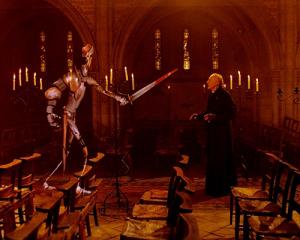
"Young Sherlock Holmes" featured the first use of live action CGI in a major Hollywood film.
Young Sherlock Holmes actually has a unique standing in popular culture, in that it was the first film to use a computer generated character, which was crafted by what was then a little division of Lucasfilm called “Pixar.” If you ever do watch it, you should also note how eerily similar it is to the later Harry Potter novels and film series; ironically or not, Young Sherlock Holmes was written by Chris Columbus, who directed the first two Potter films.
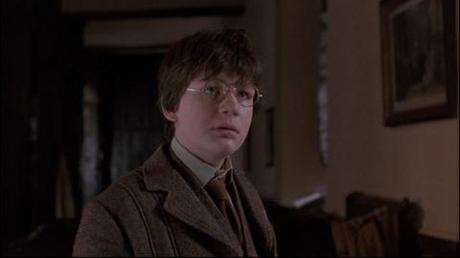
Remind you of anyone? Anyone at all?
Holmes Trivia Note: Anthony Higgins, who plays a protean Professor Moriarty in this film, later played Holmes in a failed TV pilot called 1994 Baker Street: Sherlock Holmes Returns, which was based on the premise of a cryogenically frozen Holmes being thawed out in the present day.
The Great Mouse Detective (1986)
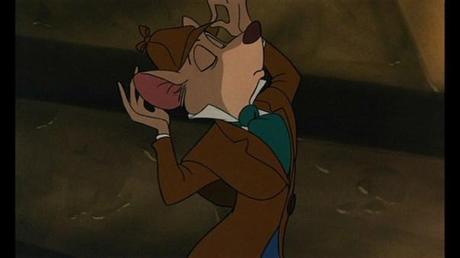
Another important film in my then burgeoning Holmes fandom, this Disney animated movie, this film was adapted from E.B. White’s Basil of Baker Street novels. Basil, a city mouse, happens to live at 221B Baker Street, which allows him to study at the feet of his idol, Sherlock Holmes, and essential becomes his anthropomorphic rodent counterpart. After taking on a new partner in the form of the Doctor Dawson, Basil becomes pitted against his arch-nemesis Professor Rattigan (voiced by Vincent Price). Not one of Disney’s best animated films, but it’s actually one of the more historically significant: after the colossal box office failure of The Black Cauldron, the company nearly shut down its feature animation division. Following the surprising financial and critical success of The Great Mouse Detective, however, Disney not only kept the division alive but placed renewed emphasis upon it, which eventually led to The Little Mermaid and a subsequent renaissance of successful and admired Disney films. Holmes Trivia: The voice of Sherlock Holmes, heard briefly, is actually that of the late Basil Rathbone; it was sampled from an old Sherlock Holmes radio programs.
Without a Clue (1988)
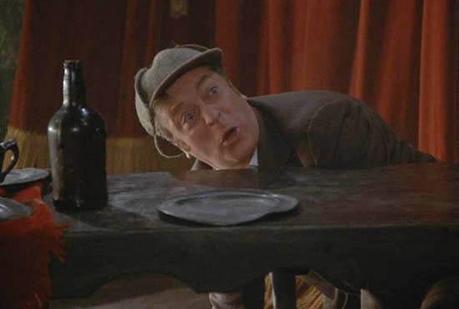
Sir Michael Caine, attempting to his film's script (I'm assuming).
You know, it’s hard to fathom that any project featuring such amazing actors as Michael Caine playing Sherlock Holmes and Ben Kingsley playing Dr. Watson would be anything less than an unqualified success. Sadly, this shabby spoof is anything but. The premise in this parody is that Watson was not actually the bumbling sidekick he was popularly regarded to be, but the actual genius and master detective of the team, with “Sherlock Holmes” being a fictional creation the good doctor concocted to avoid notoriety. When the character grew too popular, Dr. Watson hired an alcoholic thespian to play Holmes; unfortunately, the genuinely bumbling actor allows the publicity go to his head. Watson fires him, hoping to now receive all of the credit for himself, but he soon learns that the public is interested in Holmes and only Holmes. An illogical, contrived role reversal that really goes nowhere, with the two characters rendered completely unlikable by the threadbare, unfunny story. A complete waste of two such legendary actors, either of whom could have been a superb Holmes or Watson in just about any other circumstance. Holmes Trivia: The film actually reflects reality in one respect: like Watson here, Conan Doyle, tired of writing Holmes, killed off his creation in the 1891 story “The Final Problem,” only to be later pressured by the public to resurrect him; first in The Hound of the Baskervilles, and then, within continuity, in the short story “The Empty House.”
The Crucifer of Blood (1991)
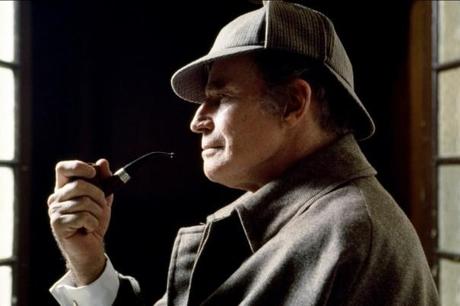
"Watson - get me my gun..."
A television movie made for TNT, this was based on Paul Giovanni’s Broadway and London stage play, which itself was based on the novel The Sign of Four. Charlton Heston plays Holmes, and besides being far too old for the part doesn’t do a very good job. The entire, limited charm of Giovanni’s play, such as it was, was based on the audience being familiar with the solution of the original The Sign of Four, which the play changes dramatically in a way that was meant to be shocking. This version, however, is just boring, poorly produced, and listlessly directed by Heston’s son, Frasier Clarke Heston. Holmes Trivia: In the original Los Angeles theatrical production with Heston over ten years earlier, the part of Watson was played by Jeremy Brett, placing him within the very select group of people who have played both Holmes and Watson in popular media.
Sherlock Holmes: The Golden Years (1991-1992)
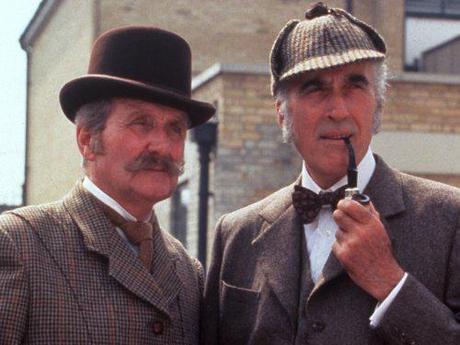
This “series” was actually a pair of television movies starring Christopher Lee as Sherlock Holmes and Patrick Macnee, once again, as Watson; the basic premise, as the name suggests was presenting older versions of the characters during the years just prior to World War I. The first film, Sherlock Holmes and the Incident at Victoria Falls saw Holmes preparing to retire to the country to raise bees, only to be called into a case that takes him to South Africa. The second, Sherlock Holmes and the Leading Lady involves Holmes and Watson traveling to Austria to track down a prototype “remote control,” which leads the detective to rekindle his romance with Irene Adler (Morgan Fairchild) and stop the Great War from breaking out a few years early. Though Lee and Macnee are ideally suited for Holmes and Watson, these movies, quite honestly, stink. They’re each bloated at almost three hours long, not to mention overly comedic, confusing, unfocused, and just plain awkward to watch. The musical scores are especially awful, and the series featured an odd gimmick of incorporating real life characters such as Elliot Ness and Theodore Roosevelt in small roles for no real discernible reason. The series was actually produced in part by the controversial former Italian Prime Minister Silvio Berlusconi’s production company.
Holmes Trivia: This series was not Christopher Lee’s first performance as Holmes; he also played the character in Sherlock Holmes and the Deadly Necklace (1962), a German produced production that Lee has always heartily criticized, in large part because the English language version overdubbed his voice with another actor’s.
The Sherlock Holmes Collection (Hallmark Channel Series) (2001-2002)
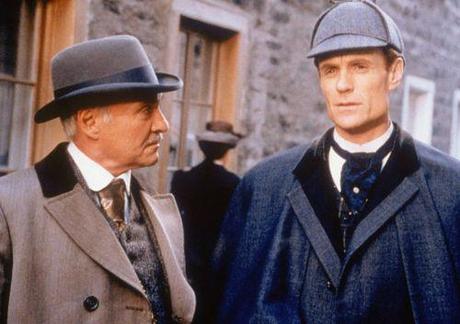
My choice for worst Sherlock Holmes film or series would be, without a doubt, these four awful TV movies made for the Hallmark Channel, which starred Matt Frewer as Holmes and Kenneth Welsh as Watson. The first three films were adaptations of The Hound of the Baskervilles, The Sign of Four, and “A Scandal in Bohemia;” the fourth was an original story centered on “vampire” attacks in London’s Whitechapel, which mercifully, at least, didn’t disgrace Conan Doyle’s work as badly as the other three did. Each of the films are just terrible, cheaply produced, written in forced and obvious fashion, and just horrendously acted. It didn’t help matters that the films were shot in Quebec, which, not surprisingly, proves to be a terrible stand-in for either Victorian London or the Old English countryside. The Hound adaptation is especially embarrassing, with the sun-soaked landscapes of Quebec used in place of the foggy, ominous moors of Dartmoor. The worst part of the series, though, was Frewer’s Holmes, who chose to play Holmes, dreadfully, as a broad caricature, complete with the phoniest English accent you’ve ever heard. These are honestly so low-quality they seemed like porno versions of Sherlock Holmes that forgot to include the porn (not that I’m complaining).
Holmes Trivia: In keeping somewhat with the sheer ineptitude of the films, Frewer’s Holmes wears the character’s trademarked deerstalker hat anywhere and everywhere he goes (though being fair, many other Holmes productions, including Rathbone’s, did the same thing). This fashion choice would have been completely inappropriate for urban wear, however; the deerstalker cap, as the name implies, is a hunting garment, and therefore would only be fashionable for country wear.
Sherlock: A Case of Evil (2002)
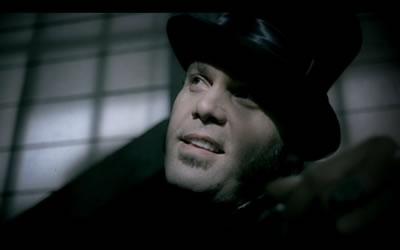
This TV movie stands as perhaps the most disastrous attempt ever to update Sherlock Holmes “for a modern audience,” focusing on a younger, rakish Sherlock (James D’Arcy), and his battles with Professor Moriarty (Vincent D’Onofrio, complete with awful British accent). Lousy stuff, with Holmes presented as a womanizing, violent, egomaniacal punk who bears nearly no relationship to his literary antecedent, and Moriarty a drug lord who gets Sherlock addicted to heroin. Just about as bad as it sounds, and perhaps even worse than that, this ranks as one of the worst Holmes incarnations ever.
Holmes Trivia: Though Professor James Moriarty has always been regarded within popular culture as Holmes’ arch-nemesis, in the original Conan Doyle stories the Napoleon of Crime only plays a direct role in two stories, the short story “The Final Problem” and the novel The Valley of Fear. Even then, he never really appears within the direct action of either story; instead, he was only recounted second hand through the perspective of Holmes and other characters. As a case in point, Watson, the narrator of the stories, never actually meets Moriarty face-to-face.
The Hound of the Baskervilles (2002)
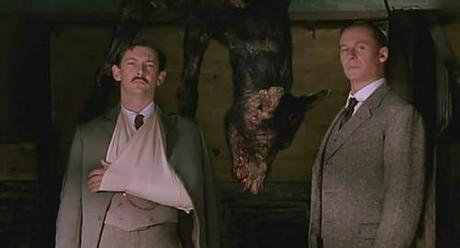
Umm...spoiler warning?
In the umpteenth retelling of the novel, this BBC production sought to embellish numerous elements of the original story to make it more exciting and intriguing. Some ideas work more than others; for instance, the choice to introduce Holmes and Watson in a Turkish bathhouse may have been too cute by half, and the decision to use CGI to create a very fake-looking hound was downright embarrassing. For these reasons, this version is genuinely despised by some. I can see why, but I never thought it was that bad; if anything, I kind of wish it had carried through on some of its ideas, especially with its teases of Holmes and Watson actually being a couple. I also liked that it took the rather modernist tract of portraying Holmes as something of a pompous jerk whose ego could very much get the better of him. Notorious ham Richard Roxburgh was mercifully restrained as Holmes, though he still manages to chew enough scenery to be occasionally annoying. My chief complaint is that some of the changes, especially the increased violence, make the story rather depressing by the end. But still, I give it points for being different, if not altogether successful.
Holmes Trivia Fact: Roxburgh, like Anthony Higgins, can lay claim to playing both Holmes and Professor Moriarty; he played the master criminal in League of Extraordinary Gentlemen. The only other actor to have done this in mass media was Orson Welles, who played both roles on the radio.
Sherlock Holmes and the Case of the Silk Stocking (2004)
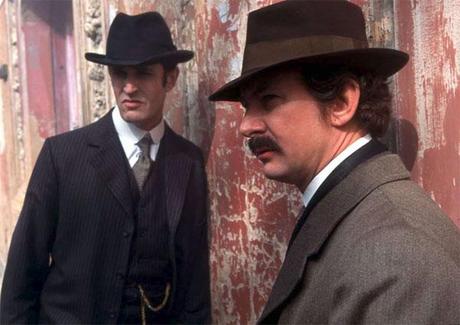
While yet another attempt to update Sherlock Holmes for a more sophisticated audience, this BBC follow-up to the previous film at least doesn’t try to reinvent the wheel. Perpetually bored and abusing drugs, Sherlock Holmes (Rupert Everett) reconnects with a long-estranged Watson (Ian Hart, reprising his Watson from Hound), who is about to marry an American psychiatrist and suffragette who proves to be an intellectual match for the misogynistic Holmes. Holmes and Watson, despite their issues with one another, begin investigating a serial murder case involving a ritual fetish, leading to Holmes having to combine elements of forensic psychology with his usual methods of deduction to catch the killer. I regret to say, I’m probably making this piece sound far more interesting than it actually was. Some fine ideas, for sure, especially with the estrangement of Holmes and Watson (a concept employed to a more entertaining effect by the Robert Downey Jr. film) and the psychosexual dimension of the crime, but it’s rather drearily done and not very exciting. Everett’s Holmes is surprisingly subdued, though the real problem is that he and Hart have absolutely no chemistry with each other. Even worse, there’s such a disparity in size between the two actors that Hart’s Watson looks like a small child next to Everett’s Holmes.
Holmes Trivia: Though this film is non-canonical, Watson was married twice in the original stories, the first time to the heroine Mary Morstan of The Sign of Four and the second to a woman whose name or background is never revealed.
Sherlock Holmes (2009)
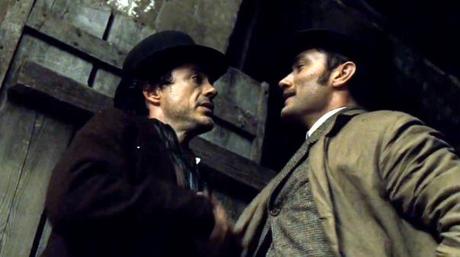
I pretty much reviewed this in my recent post, which was written when it was first released; two years later, my opinion of it hasn’t really changed that much. Though far more a cheesy action movie than compelling mystery, this was rebooted Holmes benefits from being extremely well cast, with some very amusing interplay between both Holmes (Robert Downey, Jr.) and Watson (Jude Law), who are portrayed as having something of an acrimonious dysfunctional friendship, and Holmes and Irene Adler (Rachel McAdams), who is rightfully presented as being as much Holmes’ adversary as his paramour. I also failed to give credit to Hans Zimmer’s fun music hall-style score, which represents a drastic departure from much of the classically inspired, violin-based compositions of most of the other Holmes films. In many respects, that actually sums up the central premise of the movie, in that it portrays the pulpier, low-brow aspects of Holmes’ legacy instead of the dignified drawing room analyses that marked them for many as high literature.
Holmes Trivia: The story of Sherlock Holmes centered on Holmes outsmarting a criminal mastermind who uses science to convince people he has supernatural powers; this theme of logic and deduction overcoming superstition is an incredibly common theme within Holmes literature and media, both canonical and non-canonical, with The Hound of the Baskervilles being the most salient example. In real life, though, Holmes’ creator Sir Arthur Conan Doyle was fairly open-minded to the supernatural, and actually became deeply invested in spiritualism and occultism later in life after suffering a series of painful family tragedies. Outside of Holmes, Conan Doyle also wrote in the genres of science fiction and horror; the most notable of these include The Lost World, which was set in a lost land of dinosaurs existing in the modern world, and the short story “Lot No. 249,” the first fictional work to depict a mommy being called back from the dead through mystical means.
Sherlock (2010- )
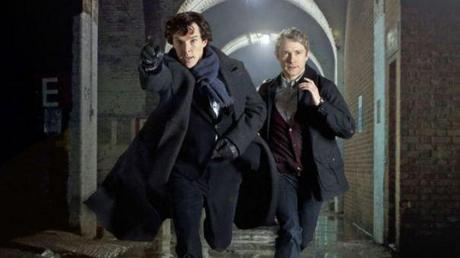
To me, the best Holmes adaptation since the Jeremy Brett episodes, this series, created by current Doctor Who show-runner Stephen Moffat and writer/comedian Mark Gatiss updates Sherlock Holmes and Dr. Watson to modern day London, while amazingly enough, remaining incredibly faithful to its source material. In this version, Dr. John Watson (Martin Freeman) is a recently discharged veteran of the Afghan War trying to adjust, with difficulty, to civilian life, while Holmes (Benedict Cumberbatch) is a brilliant, sarcastic, tech-savvy, antisocial maladroit who’s actively despised by nearly everyone who knows him. Though I originally balked when I heard the idea, this turned out to be an excellent series and one of the most compelling presentations I’ve ever seen of the character, one which simultaneously emphasizes the timeless aspects of Holmes’ appeal while portraying him through more contemporary eyes. The series has thus far has been composed of three 90 minute episodes, the narratives of which represent a briccolage of various original Holmes stories. Cumberbatch and Freeman are both terrific in their roles; Cumberbatch builds marvelously on Brett’s groundwork yet makes the part entirely his own. Freeman’s Watson is also the most detailed version of the character I’ve seen, as the writers really made it a point to focus on his psychological underpinnings as much as Holmes. This makes the character dynamic between the two characters all the more effective since it’s based less on them being diametrical opposites than being equally incomplete people.
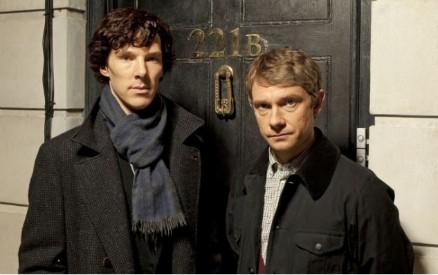
In all, the series represents something of a culmination of Holmes portrayals over the last ten years, which have gradually cast him as a socially awkward and even slightly disreputable character (Holmes in this series even labels himself “a high functioning sociopath”) whose behavior is emphasized as being abnormal and perhaps even amoral.
Holmes Trivia: Though many purists will only accept Holmes in a late Victorian/Early Edwardian setting, the fact is that Conan Doyle’s Holmes was always a futurist, not only utilizing the cutting edge of his era’s technology in solving crimes, but often actively trying to improve the science of deduction through his own research and scholarship.
(Okay, this ended up being far more comprehensive than first intended. A note about the “Holmes Trivia’ blurbs: these were all written from my own memory and came from a variety of sources that I’ve read or watched over the years that I could not honestly cite with accuracy. With that said, I verified and vetted them all online, mostly through Wikipedia and a number of other online Holmes resources.)

